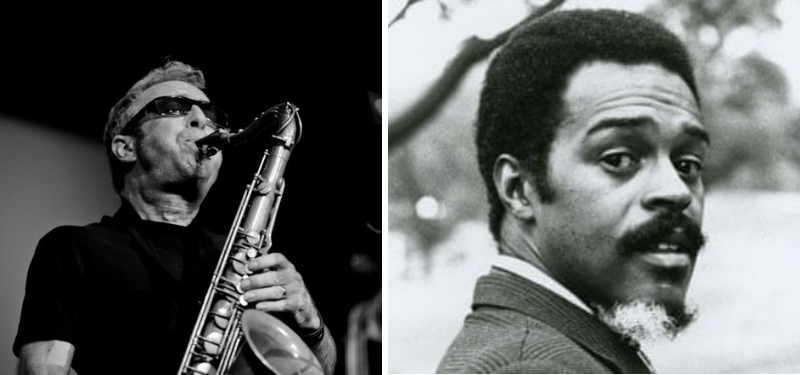Mars Willams Maps the Way to an Ayler Xmas

The Chicago-based sax player pays tribute to the free jazz hero by fusing his music with Christmas songs.
Christmas music often comes with a strong undercurrent of nostalgia as the songs evoke times that seem simpler in retrospect. That isn’t an issue for Mars Williams’ Ayler Xmas project, which steers into the heart of the tensions and uncertainties of improvised music based on pieces of adventurous Black art from the early 1960s. Williams fuses compositions by saxophone great Albert Ayler with Christmas music on Mars Williams Presents: An Ayler Xmas Vol. 1 and 2, and the decision is not just a stunt. Williams heard the same chord structures and melodies in Ayler’s music that he heard in Christmas music, and the spiritual side of Christmas music makes sense in Ayler’s compositions. As Pitchfork’s Mark Richardson wrote, “The religion [Ayler] grew up with never left him; in fact, it intensified as time wore on, taking on elements of the aquarian pantheistic New Age spirituality that was emerging in the ’60s.”
Williams play “An Ayler Xmas” in The Twilight Room of the AllWays Lounge Wednesday night at 9 p.m. with collaborators Helen Gillet, Jeff Albert, Rob Cambre, Jesse Morrow, and Paul Thibodeaux.
This show will be the second time Williams has brought this body of material to New Orleans, and the second time he played it with this lineup, with the exception of Morrow, who replaces James Singleton on bass. Because of connections he already had with the New Orleans improvised music community, he decided to bring the material here last year to see what happened if he played it with musicians other than his Chicago-based Ayler tribute group, Witches and Devils.
“I didn’t know what the final outcome was going to be, and I liked that,” Williams says.
The experience worked out so well that he has collaborated with improvisors around the world to see what changes and what stays the same. Even the instrumentation can change—in Paris, the band played electric instruments with a tendency toward noise—but he has systems in place to make sure that the fundamental Ayler character remains in place. The recently released An Ayler Xmas Vol. 2 even includes two tracks recorded live with a group in Vienna last year.
The instrumentation on road gigs is often different from that of Witches and Devils, but Williams has worked out ways to organize the improvisations to get results that are reliably Ayler-esque—an important goal since improvisation based on an improvisor’s music could easily lose touch with its source material in moments. “I actually draw out these maps that have written pieces of music,” Williams says. They include directions, the movements of the piece, and a few bits of composed music.
“I can hold up two fingers that mean ‘chart number two in that arrangement.’ That can come in at any time.”
For the performances, Williams also gives his collaborator choices. If he plays a piece of Christmas music, the others can join him on it or respond to it, either by repeating it to create the effect of a round, or by answering it in some way. Anyone is free to incorporate Christmas music in their improvisations, and the same options apply in those instances. Still, there are basic structures he tries to adhere to so that the pieces move in ways that Ayler’s improvisations moved. “At the beginning [Ayler’s] ‘Spirits,’ he would start off with this rubato, spiritual, ballad-y theme. The background under his theme is pretty free with drone-y tonalities,” Williams says. “It would go into this march-type of feel of another theme that would start slower and speed up and speed up until it broke up completely into the free. Then it would go into some improvisation. What i would do is think, Hmmm. Let’s take the drone-y part of that piece and put a Christmas song over it. What I heard in my mind was ‘O Tannenbaum.’ And play it in the style that he plays the beginning of ‘Spirits.’ From there, I go into Ayler’s march theme and we play and go into solos. In my solo, I introduce the theme to ‘The Twelve Days of Christmas.’ What I like about that is that it goes into the repetitious [sings the countdown melody] and Ayler’s music had a lot of repetition in it as well. Then the directions I have on this map I draw out are if you hear me start introducing this theme, you start quoting the themes too. So it’s kind of loose and free.”
The project forces Williams to listen closely to Ayler and his pieces to hear elements that can feed the fusion. Williams played the saxophone part in The Waitresses’ 1982 Christmas classic, “Christmas Wrapping,” and he included it on An Ayler Xmas Vol. 2, pairing it with Ayler’s “Love Cry.” “Love Cry” has, he says, “this one little melody at the beginning of it. It’s a two-note little theme that he does as a question and answer.” With mild alterations to the “Christmas Wrapping” phrasing, its fanfare mimics that signature theme.
The project sounds academic, as if Williams thinks of the Christmas songs as purely musical compositions devoid of associated significance. That’s not the case.
“I think it’s a joyous music,” Williams says. “It’s a spiritual music. There’s praise in it, but there’s also celebration, and I try to bring that all out. That’s what Christmas music is to me.”






